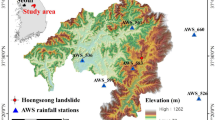Abstract
In this paper, the material point method (MPM) is presented as a tool for simulating large deformation, gravity-driven landslides. The primary goal is to assess the interaction of these flow-like events with the built environment. This includes an evaluation of earthen mounds when energy dissipating devices are placed in the path of a snow avalanche. The effectiveness of the embankments is characterized using displacement, velocity, mass, and energy measures. A second example quantifies the force interaction between a landslide and a square rigid column. Multiple slide approach angles are considered, and various aspects of the impact force are discussed.
Similar content being viewed by others
References
Andersen, S., Andersen, L.: Modelling of landslides with the material-point method. Comput. Geosci. 14, 137–147 (2010)
Ataie-Ashtiani, B., Shobeyri, G.: Numerical simulation of landslide impulsive waves by incompressible smoothed particle hydrodynamics. Int. J. Numer. Methods Fluids 56(2), 209–32 (2008). doi:10.1002/fld.1526
Brown, R.L., Lang, T.E., St Lawrence, W.F., Bradley, C.C.: A failure criterion for snow. J. Geophys. Res. 78(23), 4950–4958 (1973)
Chen, S.C., Peng, S.H., Capart, H.: Two-layer shallow water computation of mud flow intrusions into quiescent water. J. Hydraul. Res. 45(1), 13–25 (2007)
Denlinger, R., Iverson, R.: Flow of variably fluidized granular masses across three-dimensional terrain. 2. Numerical predictions and experimental tests. J. Geophys. Res. 106(B1), 553–66 (2001)
Guimaraes, R., Trancoso, R., De Carvalho, G., Fernandes, N., Do Amaral Vargas, E.: De Martins E (2008) Identification of the affected areas by mass movement through a physically based model of landslide hazard combined with a two-dimensional flood routing model for simulating debris flow. In: International Geoscience and Remote Sensing Symposium (IGARSS), pp. 3035–3038, Barcelona
Highland, L.M.: Estimating landslide losses—preliminary results of a seven-state pilot project. Tech. Rep. 2006:1032, USGS (2006). http://pubs.usgs.gov/of/2006/1032/pdf/OFR-2006-1032.pdf
Iverson, R., Denlinger, R.: Flow of variably fluidized granular masses across three-dimensional terrain. 1. coulomb mixture theory. J. Geophys. Res 106(B1), 537–52 (2001)
Iverson, R., Vallance, J.: New views of granular mass flows. Geology 29(2), 115–118 (2001). doi:10.1130/0091-7613(2001)029<0115:NVOGMF>2.0.CO;2
Iverson, R., Costa, J., LaHusen, R.: Debris-flow flume at H.J. Andrews Experimental Forest, Oregon, open-file report 92-483. Tech. rep., U.S. Geological Survey (1992). http://vulcan.wr.usgs.gov/Projects/MassMovement/Publications/OFR92-483
Kulhawy, F., Mayne, P. (eds.): Manual on estimating soil properties for foundation design (EPRI). Cornel University (1990)
Lin, M.L., Wang, K.L.: Seismic slope behavior in a large-scale shaking table model test. Eng. Geol. 86(2-3), 118–133 (2006). doi:10.1016/j.enggeo.2006.02.011
Mackenzie-Helnwein, P., Arduino, P., Shin, W., Moore, J.A., Miller, G.R.: Modeling strategies for multiphase drag interactions using the material point method. Int. J. Numer. Methods Eng. 83(3), 295–322 (2010)
Mast, C., Mackenzie-Helnwein, P., Arduino, P., Miller, G., Shin, W.: Mitigating kinematic locking in the material point method. J. Comput. Phys. 231(16), 5351–5373 (2012)
Mast, C., Arduino, P., Mackenzie-Helnwein, P., Miller, G.: Simulating granular column collapse using the material point method. Acta Geotechnica Submitted for publication (2013)
Mast, C.M.: Modeling landslide-induced flowinteractions with structures using the material point method. PhD thesis. WA, Seattle (2013)
McDougall, S., Hungr, O.: A model for the analysis of rapid landslide motion across three-dimensional terrain. Can. Geotech. J. 41(6), 1084–1097 (2004). doi:10.1139/T04-052
Moriguchi, S., Borja, R.I., Yashima, A., Sawada, K.: Estimating the impact force generated by granular flow on a rigid obstruction. Acta Geotech. 4(1), 57–71 (2009)
Nicot, F.: Constitutive modelling of snow as a cohesive-granular material. Granul. Matter 6, 47–60 (2004). doi:10.1007/s10035-004-0159-9
Petrovic, J.J.: Review mechanical properties of ice and snow. J. Mater. Sci. 38, 1–6 (2003)
Reid, M., Brien, D., LaHusen, R., Roering, J., De La Fuente, J., Ellen, S.: Debris-flow initiation from large, slow-moving landslides. In: International Conference on Debris-Flow Hazards Mitigation: Mechanics, Prediction, and Assessment, Proceedings, Davos, Switzerland, vol 1, pp. 155–166 (2003)
Sadeghirad, A., Brannon, R., Burghardt, J.: A convected particle domain interpolation technique to extend applicability of the material point method for problems involving massive deformations. Int. J. Numer. Methods Eng. 86(12), 1435–1456 (2011)
Salm, B.: Mechanical properties of snow. Rev. Geophys. 20(1), 1–19 (1982)
Savage, S., Iverson, R.: Surge dynamics coupled to pore-pressure evolution in debris flows. In:International Conference on Debris Flow Hazards Mitigation: Mechanics, Prediction, and Assessment, Proceedings, Davos, Switzerland, vol 1, pp. 503–514 (2003)
Shin, W., Miller, G.R., Arduino, P., Mackenzie-Helnwein, P.: Dynamic meshing for material point method computations. Int. J. Comput. Math. Sci. 4(8), 379–387 (2010)
Simo, J.C.: Numerical analysis and simulation of plasticity. In: Ciarlet, P., Lions, J. (eds.) Numerical methods for solids (Part 3) numerical methods for fluids (Part 1), handbook of numerical analysis, vol. 6, pp. 183–499. Elsevier (1998)
Sulsky, D., Chen, Z., Schreyer, H.: A particle method for history-dependent materials. Comput. Methods Appl. Mech. Eng. 118(1-2), 179–196 (1994)
Sulsky, D., Zhou, S., Schreyer, H.L.: Application of a particle-in-cell method to solid mechanics. Comput. Phys. Commun. 87(1–2), 236–252 (1995)
Swan, C.C.: A smooth, three-surface elasto-plastic cap model: Rate formulation, integration algorithm, and tangent operators (2006)
Teufelsbauer, H., Wang, Y., Pudasaini, S., Borja, R., Wu, W.: DEM simulation of impact force exerted by granular flow on rigid structures. Acta Geotech. 6(3), 119–133 (2011)
Tohari, A., Nishigaki, M., Komatsu, M.: Laboratory rainfall-induced slope failure with moisture content measurement. J. Geotech. Geoenviron. 133(5), 575–587 (2007). doi:10.1061/(ASCE)1090-0241(2007)133:5(575)
Wieckowski, Z.: Modeling of silo discharge and filling problems by the material point method. Task Q. 7(4), 701–721 (2003)
Wieckowski, Z.: The material point method in large strain engineering problems. Comput. Methods Appl. Mech. Eng. 193(39-41), 4417–4438 (2004)
Zanuttigh, B., Lamberti, A.: Experimental analysis of the impact of dry avalanches on structures and implication for debris flows. J. Hydraul. Res. 44(4), 522–534 (2006)
Author information
Authors and Affiliations
Corresponding author
Rights and permissions
About this article
Cite this article
Mast, C.M., Arduino, P., Miller, G.R. et al. Avalanche and landslide simulation using the material point method: flow dynamics and force interaction with structures. Comput Geosci 18, 817–830 (2014). https://doi.org/10.1007/s10596-014-9428-9
Received:
Accepted:
Published:
Issue Date:
DOI: https://doi.org/10.1007/s10596-014-9428-9




